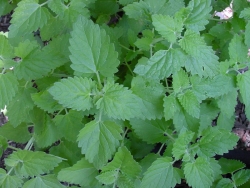Growing Catnip
Common name for Nepeta cataria, a hardy perennial herb of the Mint Family, with pungent fragrance which is highly attractive and exciting to cats.
Catnip grows to a height of three or four feet, and features downy, light green foliage with small lavender flowers that grow on spikes up to five inches long.
Catnips grow well in almost any soil, but does best in a moderately rich loam that is well-draining. It’s aroma increases when grown in sandy soil or via the hydroponic method. It will grow acceptably in either sun or shade.
Catnips is easily propagated by seed, stem cuttings, or rootball division. Seed should be sown in rows late in fall or early in the spring and lightly covered. When sown in the fall, a denser crop is ususally achieved. When plants reach five inches tall, thin so that they stand 12 to 18 inches apart. Catnip can also be started early indoors and transplanted outside after the last chance of frost.
Cats aren’t the only creatures that benefit from Catnip as the leaves may be candied to enjoy as a dessert and it’s oil is used to relieve the symptoms of headaches and nervousness.
Catnip grows best in full sun combined with average, well drained soil. It grows well in hydroponics as well. It is a perennial herb of the mint family that will grow from 3-5 feet tall. Water them regularly. Cut out last years spent stems in early spring, which creates room for new ones. Cutting the plants completely down after the first bloom set will allow enough time for the plant to completely regrow and bloom again.
Plant Height
Catnip grows to a height of 3 to 4 feet (90 – 120cm).
Plant Spacing
Catnip plants should be spaced between 15 and 18 inches (38 and 45 cm) apart.
Preferred Soil pH Range
Catnip will grow in a relatively wide pH range between 6.1 (mildly acidic) and 7.8 (mildly alkaline).
Propagation
From seed. Start seeds indoors before last frost.
Soil Requirements
Well drained, average soil.
Alternative Growing Media
Soilless potting mixes, perlite, vermiculite, rockwool, coco peat, Oasis foam.
Time From Seed to Saleable Plant
Sow in plugs or seedflats 12 to 15 weeks before sale. Seeds to finished plugs, 8 to 10 weeks; plugs to saleable plants, 3 to 5 weeks.
Sun & Lighting Requirements
Catnip grown outdoors prefers full sun but will tolerate some shade.
USDA Hardiness
Zones 3a through 9b.
Water Requirements
Water on a regular schedule, taking care to not overwater.
Potential Pests & Diseases
Whitefly, spider mites. Minimal disease issues.
Special Notes
Catnip may be considered a noxious weed or invasive plant in some areas. Catnip is known to attract bees, butterflies or birds and has fragrant blossoms. Catnip self-sows freely; remove flowers (deadhead) if you do not want volunteer seedlings the following season.
